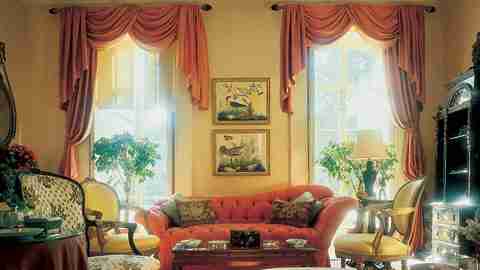View Slideshow

The lady with the misleadingly ecclesiastical name Sister Parish did nevertheless believe in the divine power of decoration, in the healing properties of glamour and romance. For six decades she held the reins of taste, never loosening her formidable grip on a certain kind of cozy old-money look, part opulent, part hand-me-down.
Seasoned as she admittedly was by the English country house aesthetic and by Sibyl Colefax, John Fowler, and Nancy Lancaster in particular, she was and remained an American original (original, too, in the sense that she could not exactly be copied). She was at once very vintage and forever fashionable—nostalgia was far from the only note being struck here. As she explained, "Innovation is often the ability to reach into the past and bring back what is good, what is beautiful, what is useful, what is lasting."
Her interiors as a rule were refreshingly unstudied, unself-conscious, and unstrained—perhaps because, in pulling rooms together, she often simply "felt" her way along. Indeed, the precise and scrupulous Parsons-trained Albert Hadley, since 1964 Sister Parish's partner in renown, has spoken of her style of working as "baroque" and "freewheeling." What, then, was the secret of her rooms' glinting radiance? Their ingredients were repeatedly these: floors elaborately painted and stained; Anglo-Franco furniture that had seen good—but definitely not better—days; flashes and flares of daredevil color (yet she always knew how not to go too far); masses and slashes of luscious chintz (nobody could bring a room to flower better than Sister Parish); crocheted throws and needlepoint pillows and chair covers; humble mattress ticking for slipcovers; hooked rugs and rag rugs; starched organdy; botanical prints; painted lampshades; dog paintings; exotic-wood bookcases; white wicker; patches of quilts; and bales of baskets.
A Sister Parish room overflowed, to be sure—but buoyantly. It was romantic and whimsical but not sentimental; and, always, it was light—the rug might be Aubusson, the mirror Chippendale and the chandelier Waterford, but she undercut these "brand names" with all manner of charming distractions.
Her living rooms lived : They were friendly to the world—"comfortable for 40, comfortable for four." And her bedrooms, Billy Baldwin raved, were "the most attractive, seductive, and luxurious ... of any decorator in America ... simply the best thing that has ever been in the history of the art." Her libraries, sitting rooms, and morning rooms also had a convincingness, a depth as well as a warmth, looking as if they had evolved naturally around their owners over time. Not only were the objects and pieces of furniture themselves occasionally offbeat and frequently arranged offhand, they were sometimes even actually placed off-center, for Sister Parish believed that, as someone once said, "to be perfect the perfect must be imperfect." Nonpareil, then, in tenor, timber, and tone (undertones being as important to her as overtones), they were all rooms in which the center held.
She was born Dorothy May Kinnicutt in 1910 (the nickname Sister, given her by a brother, stuck) in the heart of the New Jersey hunt country, in the same four-poster that she was still sleeping in as an octogenarian—continuity was the running theme in her life as well as her work. Her parents maintained footholds in New York and in Maine, another strong lifelong influence, and a toehold in Paris, so she was exposed—and disposed—early on to art and antiques. But her taste and judgment were inborn rather than learned. As she would be the first to tell you, she started out "knowing" very little, never having read a book on decorating or served any kind of apprenticeship. She attended Chapin and Foxcroft, made her debut, and fell in love with Henry Parish II, whom she married at the age of 19. They moved into a small white farmhouse in Far Hills, New Jersey, where, already with the instincts of a "lifestyle" pioneer, she lost no time in applying white striped paper to the walls, using white mattress ticking for the draperies, painting the bedroom floor cherry-red with white diamonds, and covering the bed with white silk taffeta with a border of flowers.
Three years later, when the Depression hit both her husband's and her father's holdings hard, she did a thing unheard of in her circle and went to work. Renting a 14-by-14-foot room in Far Hills for $35 a month, she outfitted it with a wicker chair and desk and put up a sign that said "Mrs. Henry Parish II, Interiors." (Affronted at the thought of having a relation in trade, Harry Parish's aunt disinherited him in favor of her cousin Eleanor Roosevelt.) Friends—not to mention friends of friends—enchanted by what she had done with her own house, appealed to her for help with theirs, and soon Sister Parish was out of the gate and off and running.
Over the ensuing decades her client list would ring with such sonorous names as Astor, Vanderbilt, Whitney, Paley, Mellon, Getty, Engelhard, Annenberg, Bronfman, and Rockefeller. And, most familiarly, Kennedy. After having decorated a Georgetown house for the young Massachusetts senator and his wife, Sister was once again retained by Jacqueline Kennedy to do up a residence for the couple—the private family quarters in the White House, including the oval drawing room on the second floor, where the president liked to receive foreign dignitaries. But the First Lady of American Decorating, who was used to holding her own with heads of state, was fired by the nation's First Lady for telling little Caroline to get her feet off the upholstery.
Sister Parish was by turns affectionate and impatient; she was famously scathing and could be witheringly to the point. Her custom at the start of any project was, with sure and measured tread, to wheel a tea cart through the house, purging it of bric-a-brac that failed to make her cut. How many intimidated clients held their breath as Sister's determined tea cart came rolling along!
